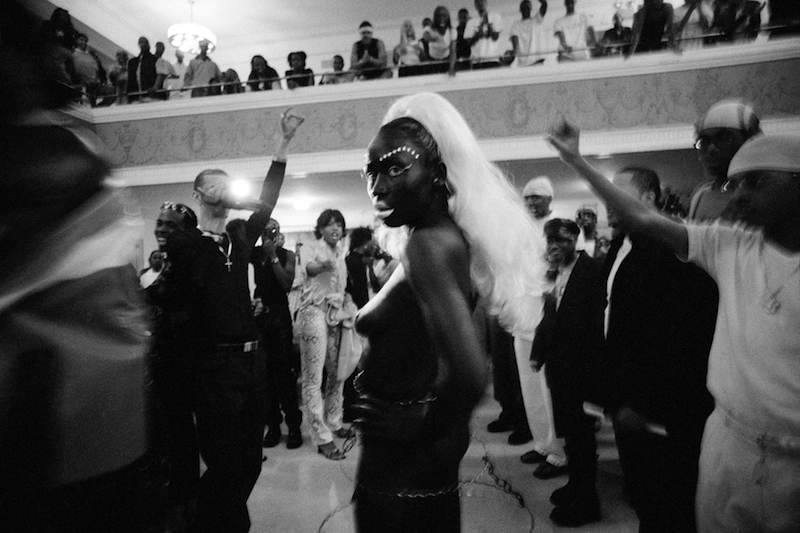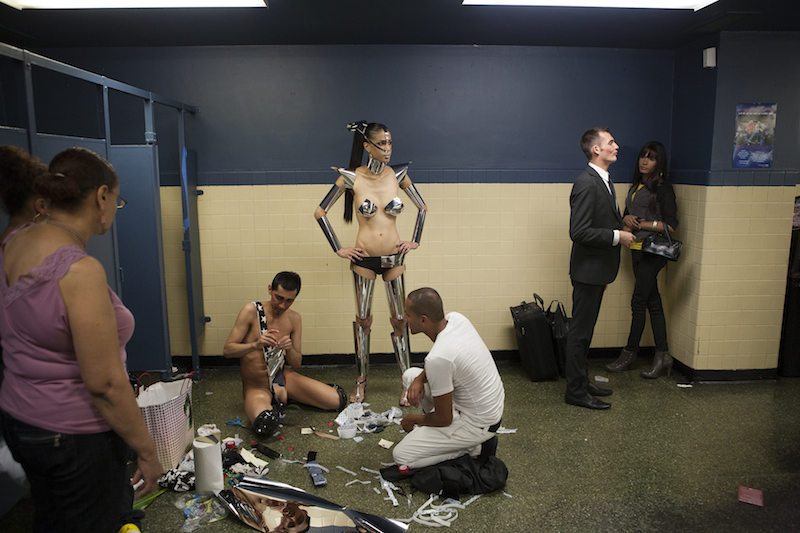
Gerard H. Gaskin, Baby (painted black) at Tony, Andrea, and Eric Ball Brooklyn, NY, 2000. Courtesy the artist.
An Amazon search for photography books returns well over 100,000 titles. Narrow that search to explicitly gay or queer portraiture and the return is infinitesimal by comparison. The photographer Gerard H. Gaskin knew when he secured his first book deal that it was a feat not just for him but also for the queer community he’s photographed for nearly twenty years. Gaskin has been called the official photographer of the house ballroom scene that was “born out of a need for black and Latino gays to have a safe space to express themselves,” he writes. “My images try to show a personal and intimate beauty, pride, dignity, courage, and grace that has been painfully challenged by mainstream society.”
On an overcast afternoon, Gaskin and I met for lunch in the Chelsea/Flatiron district of New York City, not far from the Art21 headquarters. Between bites of thin-crust cheese pizza topped with black olives, he told me about the long road to Legendary: Inside the House Ballroom Scene, which comes out this month. “I shopped the book to publishers for years.”1 He encountered rejection and sometimes blatant racism. Eventually Gaskin decided to self-publish—and then he received a call from Duke University informing him that he had won the sixth biennial First Book Prize in Photography, cosponsored by the Center for Documentary Studies and the Honickman Foundation. Selected by Deborah Willis, the preeminent photo historian, Gaskin’s book beat out nearly two hundred entries.
Legendary features photographs taken between 1994 and 2013 at balls in New York City, Philadelphia, and Washington, DC. In Baby (painted black) (2000), the pulse of the room is palpable, Baby’s confidence obvious and enviable. Her body is the canvas on which she’s combined extremes—a sensational blackness with hair and eyelashes like Barbie. At the balls, “they play with what is light or dark, straight or gay,” said Gaskin. Dichotomies and so-called norms are deconstructed, reconfigured, unhinged.
Gaskin has gotten to know the ball scene well, and people in the scene know him. In the middle of our lunch, he shouted a friendly hello to a tall, gorgeously chocolate man passing our outdoor table. “I photographed him at a ball; he was wearing a bright orange suit,” Gaskin recounted. It appears Gaskin is part of the community in ways that Jennie Livingston and Madonna perhaps never were. Even though those women are credited with pushing the ballroom scene from the underground into the mainstream, their methods were met (justifiably) with questions of appropriation and exploitation. Gaskin is also an outsider, yet you get the sense that, between shutter snaps, he’s walking in these balls, too. His gaze is not so much anthropological as it is familial.
Born in Trinidad, Gaskin was eight years old when his family moved to the US and settled in Queens, New York. He struggled in school but took pleasure in racing bikes around the city. Gaskin would find his way to photography through the Tour de France. During his senior year of high school, he traveled to the event with a friend who “had a real camera” and they photographed the American cyclist Greg LeMond. “That was where it all started,” said Gaskin. He returned to home and asked his mother for a single-lens reflex camera (SLR). Gaskin’s mother granted his wish but didn’t live to see her son’s first book; she succumbed to cancer two days after he received the call from Duke University. And two days after her passing, his brother died in “a freak accident.” Understandably, Gaskin carries mixed emotions about the launch of Legendary.
Gaskin has had many teachers, none as influential as Jules Allen, his photo professor at Queensborough Community College. “I fell in love with the idea of what Jules Allen was: a hip dude who listened to Bach and Beethoven but knew about hip-hop. I basically turned myself into his shadow.” That Allen is black was significant; photographers of color face their own set of obstacles, something to which Gaskin alluded as he talked about his career. He acknowledged the fortune of being engulfed in Allen’s community. “I learned the ropes by assisting and hanging out with these black photographers in New York. I assisted everyone I could.” Gaskin remains hardworking and humble. He finished his pizza, expressed appreciation, and headed off to a shoot.
Gerard H. Gaskin resides in Syracuse, New York. His photos have appeared in the New York Times, Newsday, Black Enterprise, OneWorld, Teen People, Caribbean Beat, and DownBeat. His book Legendary: Inside the House Ballroom Scene is available via Amazon. A discussion and book signing will take place at New York University’s Tisch School of the Arts on November 19 from 6 to 8pm.
________
1. This and all following quotes are from the author’s conversation with Gaskin on July 25, 2013.






